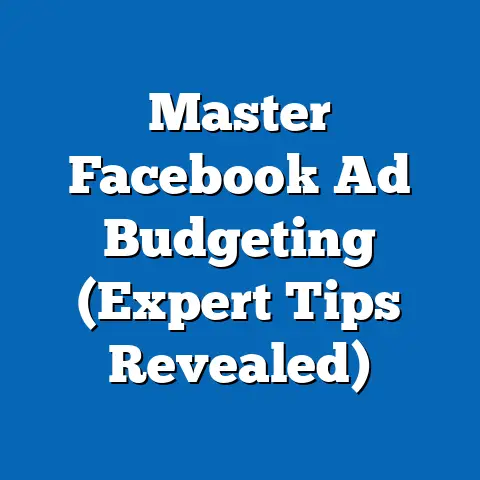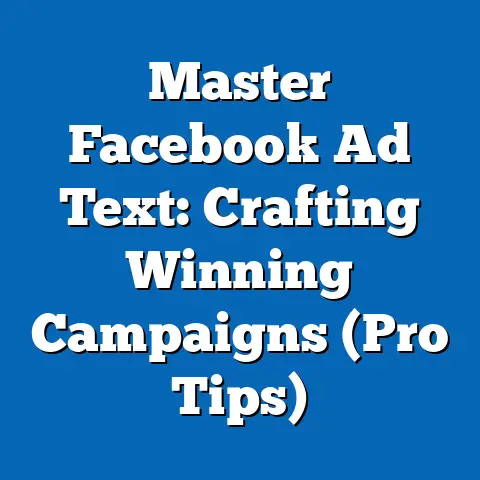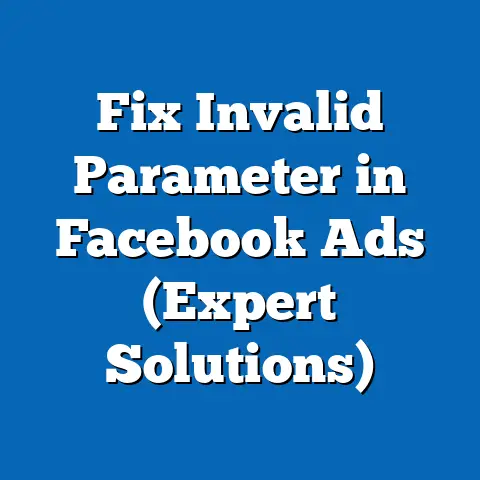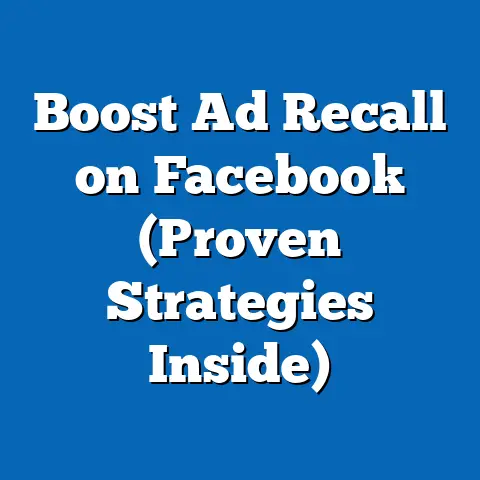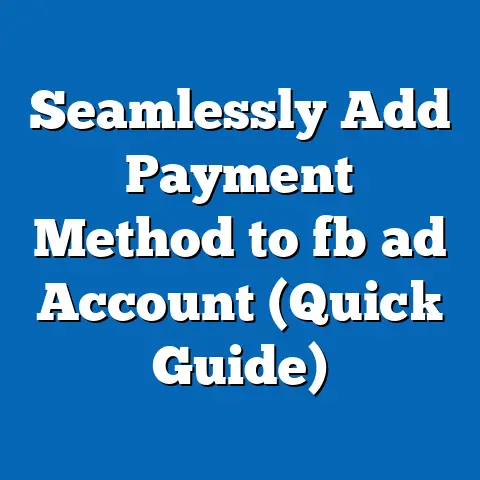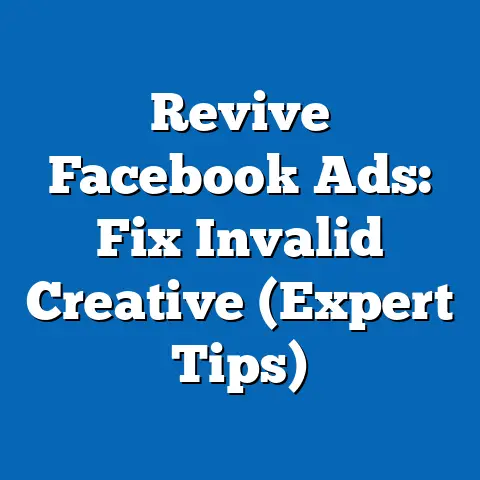Unlock Top Video fb ad Secrets (Proven Strategies Revealed)
Video is king. It’s a phrase you hear constantly in the digital marketing world, and for good reason. In today’s fast-paced, visually-driven online environment, video ads on Facebook have become an undeniable force. They grab attention, tell stories, and drive results in ways that static images simply can’t match. I’ve personally seen businesses transform their Facebook presence and skyrocket their sales just by incorporating strategic video advertising.
But here’s the thing: creating a compelling video is only half the battle. To truly unlock the potential of video ads on Facebook, you need to understand how to budget effectively, target the right audience, and continuously optimize your campaigns. It’s not about just throwing money at the problem; it’s about making smart, data-driven decisions that maximize your return on investment.
Think of it like this: you could have the most amazing movie ever made, but if nobody knows about it, it’ll never reach its audience. Facebook video ads are your distribution channel, and understanding how to use them effectively is crucial. So, let’s dive into the secrets that will help you create video ads that not only capture attention but also drive real business results. We’ll explore everything from budgeting models to compelling content creation, precise audience targeting, and insightful performance analysis. Get ready to transform your Facebook advertising strategy and unleash the power of video!
Understanding Budget Options for Facebook Video Ads
One of the first and most crucial decisions you’ll make when launching a Facebook video ad campaign is setting your budget. It’s easy to get overwhelmed, but breaking down the available options and understanding their nuances can make a world of difference. I’ve seen too many businesses either overspend without seeing results or underspend and miss out on valuable opportunities. Finding that sweet spot is key.
Different Budgeting Models
Facebook offers two primary budgeting models:
- Daily Budget: This allows you to set an average amount you’re willing to spend each day. Facebook will try to spend that amount, but some days it might spend slightly more or less. It’s a good option if you want a consistent level of ad delivery throughout the month.
- Lifetime Budget: With this model, you set a total budget for the entire duration of your campaign. Facebook will then optimize your spending across the entire period, potentially spending more on days it believes will yield better results. This is great if you have a specific campaign timeframe in mind.
My Experience: I often prefer using a daily budget for ongoing campaigns, as it provides more consistent results and allows me to easily monitor daily performance. However, for short-term promotional campaigns, a lifetime budget can be more efficient, allowing Facebook to optimize spending during peak periods.
Choosing the Right Budget
Deciding which budget model to use is one thing, but determining the actual amount to spend is another. Several factors come into play:
- Campaign Goals: What are you trying to achieve? Brand awareness campaigns typically require a broader reach and, therefore, a larger budget. Conversion-focused campaigns, on the other hand, might benefit from a more targeted approach with a potentially lower budget.
- Target Audience Size: A larger target audience generally requires a larger budget to reach a significant portion of them.
- Competition: If you’re targeting a highly competitive audience, you might need to increase your budget to stand out from the crowd.
- Expected Outcomes: Consider the potential revenue generated by each conversion. This will help you determine how much you can afford to spend to acquire a customer.
Pro Tip: Start small and scale up. Don’t blow your entire budget on day one. Begin with a smaller budget and gradually increase it as you see positive results.
Cost Considerations
Understanding the different cost metrics associated with Facebook video ads is crucial for effective budget management:
- CPM (Cost Per Mille): This is the cost you pay for every 1,000 impressions (times your ad is shown). CPM is useful for awareness campaigns where you want to reach as many people as possible.
- CPC (Cost Per Click): This is the cost you pay each time someone clicks on your ad. CPC is relevant for campaigns driving traffic to your website.
- CPA (Cost Per Acquisition): This is the cost you pay for each conversion (e.g., a purchase, a lead, a sign-up). CPA is the most important metric for campaigns focused on generating specific actions.
Real-World Example: I recently ran a campaign for an e-commerce client. Initially, our CPM was high, indicating that our ad was being shown to a broad, less-targeted audience. By refining our targeting and improving our ad creative, we were able to significantly lower the CPM and increase the overall ROI of the campaign.
Allocating Budget for Testing
Never underestimate the power of A/B testing. It’s the key to unlocking the full potential of your video ads. I always recommend allocating a portion of your budget specifically for testing different ad creatives, targeting options, and placements.
- Ad Creatives: Test different video lengths, styles, and messaging.
- Targeting Options: Experiment with different demographics, interests, and behaviors.
- Placements: Try running your ads on different platforms, such as Facebook News Feed, Instagram Feed, and Audience Network.
Actionable Insight: Create multiple ad sets with slightly different variations and run them simultaneously. Analyze the results and focus your budget on the best-performing variations. This iterative process will help you continuously improve your campaign performance.
Key Takeaway: Understanding the different budgeting models, cost metrics, and the importance of testing is essential for maximizing your ROI on Facebook video ads. Start small, test frequently, and scale up as you see positive results.
Crafting Compelling Video Content
Budget aside, the quality of your video content is paramount. You can have the perfect budget and targeting, but if your video is boring, irrelevant, or poorly produced, you’ll struggle to achieve your goals. I’ve seen countless campaigns fail simply because the video content didn’t resonate with the audience.
Importance of Video Quality
In today’s visually-saturated world, viewers have incredibly high expectations. A grainy, poorly lit video will immediately turn them off. High-quality video production is essential for:
- Creating a Positive Impression: A professional-looking video conveys credibility and trustworthiness.
- Capturing Attention: High-resolution visuals and clear audio are more likely to grab attention and keep viewers engaged.
- Conveying Your Message Effectively: Clear visuals and audio ensure that your message is easily understood.
Technical Specifications: Aim for a resolution of at least 1080p (Full HD) and ensure that your audio is clear and free from background noise.
Hooking Viewers Early
The first few seconds of your video are critical. You need to grab viewers’ attention immediately and give them a reason to keep watching. Here are some effective hook strategies:
- Ask a Question: Start with a compelling question that resonates with your target audience’s pain points or aspirations.
- Make a Bold Statement: Open with a surprising or thought-provoking statement that challenges viewers’ assumptions.
- Show a Visual Teaser: Use a captivating visual snippet to pique viewers’ curiosity.
- Highlight a Problem: Immediately address a common problem that your target audience faces.
Example: If you’re advertising a weight loss product, you could start with a visual of someone struggling to button their jeans, followed by the question, “Tired of feeling uncomfortable in your clothes?”
Storytelling Techniques
Human beings are wired for stories. Incorporating storytelling techniques into your video ads can make them more engaging, memorable, and persuasive.
- Identify Your Hero: Who is the main character in your story? Make sure they are relatable to your target audience.
- Present a Conflict: What challenge or obstacle does your hero face?
- Offer a Solution: How does your product or service help your hero overcome the conflict and achieve their goals?
- Create an Emotional Connection: Evoke emotions like joy, empathy, or inspiration to create a deeper connection with your audience.
My Insight: I’ve found that videos that tell a compelling story are far more likely to be shared and remembered than those that simply list features and benefits. Focus on creating a narrative that resonates with your target audience’s values and aspirations.
Call-to-Action (CTA)
A strong call-to-action is essential for driving conversions. Tell viewers exactly what you want them to do after watching your video.
- Be Clear and Concise: Use simple, direct language that leaves no room for ambiguity.
- Create a Sense of Urgency: Use words like “now,” “today,” or “limited time” to encourage immediate action.
- Make it Visually Prominent: Ensure that your CTA is easy to see and click on.
- Match Your CTA to Your Campaign Goals: If you want to drive traffic to your website, use a CTA like “Learn More.” If you want to generate leads, use a CTA like “Sign Up Now.”
Practical Example: Instead of a generic “Click Here” button, try something more specific and compelling, like “Get Your Free Guide Now” or “Shop the Sale Today.”
Key Takeaway: Compelling video content is the cornerstone of a successful Facebook video ad campaign. Focus on creating high-quality videos that capture attention, tell a story, and include a strong call-to-action.
Targeting the Right Audience
Even the most amazing video content will fall flat if it’s not shown to the right people. Effective audience targeting is crucial for maximizing your ROI and ensuring that your message reaches the individuals who are most likely to be interested in your product or service. I’ve seen businesses waste thousands of dollars by targeting the wrong audience. It’s like shouting into the void!
Audience Insights
Facebook provides a wealth of data and tools to help you understand your target audience. Take advantage of these resources to refine your targeting and improve your campaign performance.
- Facebook Audience Insights: This tool provides detailed information about the demographics, interests, and behaviors of people on Facebook. Use it to identify potential target audiences and gain a deeper understanding of their preferences.
- Custom Audiences: Create custom audiences based on your existing customer data, such as email lists, website visitors, or app users. This allows you to target individuals who are already familiar with your brand.
- Lookalike Audiences: Expand your reach by creating lookalike audiences based on your existing custom audiences. Facebook will identify individuals who share similar characteristics and behaviors with your existing customers.
Strategic Tip: Analyze your existing customer data to identify common traits and interests. Use this information to create highly targeted audiences on Facebook.
Demographic and Interest Targeting
Facebook’s demographic and interest targeting options allow you to reach specific groups of people based on their age, gender, location, education, interests, and behaviors.
- Demographics: Target individuals based on their age, gender, location, education, relationship status, and job title.
- Interests: Target individuals based on their interests, hobbies, and activities.
- Behaviors: Target individuals based on their purchase behavior, device usage, and other online activities.
Example: If you’re selling organic baby food, you could target parents aged 25-45 who are interested in organic food, healthy living, and parenting.
Retargeting Strategies
Retargeting is a powerful technique that allows you to show ads to individuals who have previously interacted with your video content or visited your website.
- Video View Retargeting: Target individuals who have watched a certain percentage of your video (e.g., 25%, 50%, 75%). This allows you to reach those who have shown a genuine interest in your message.
- Website Retargeting: Target individuals who have visited specific pages on your website. This allows you to show them relevant ads based on their browsing behavior.
Personal Anecdote: I once ran a retargeting campaign that generated a 300% increase in conversions. By showing targeted ads to individuals who had previously visited our website, we were able to re-engage them and drive them further down the sales funnel.
Utilizing Engagement Metrics
Pay close attention to your engagement metrics to refine your audience targeting and improve your ad performance over time.
- View-Through Rate (VTR): This measures the percentage of people who watch your video all the way through. A low VTR might indicate that your video isn’t engaging enough or that you’re targeting the wrong audience.
- Engagement Rate: This measures the percentage of people who interact with your video (e.g., likes, comments, shares). A low engagement rate might indicate that your video isn’t resonating with your audience.
- Click-Through Rate (CTR): This measures the percentage of people who click on your ad. A low CTR might indicate that your ad copy isn’t compelling enough or that you’re not targeting the right audience.
Actionable Insight: Continuously monitor your engagement metrics and make adjustments to your audience targeting as needed. Don’t be afraid to experiment with different targeting options to see what works best.
Key Takeaway: Targeting the right audience is essential for maximizing your ROI on Facebook video ads. Use Facebook’s audience insights tools, demographic and interest targeting options, and retargeting strategies to reach the individuals who are most likely to be interested in your product or service.
Analyzing and Optimizing Video Ad Performance
Launching your video ad campaign is just the beginning. The real work starts when you begin analyzing your results and optimizing your campaign for maximum performance. I’ve seen too many businesses launch campaigns and then simply “set it and forget it.” This is a recipe for disaster! Continuous monitoring and optimization are crucial for achieving your goals.
Key Performance Indicators (KPIs)
Identifying the right KPIs is essential for measuring the success of your video ad campaigns. Focus on the metrics that are most relevant to your business goals.
- View-Through Rate (VTR): As mentioned earlier, this measures the percentage of people who watch your video all the way through.
- Engagement Rate: This measures the percentage of people who interact with your video (e.g., likes, comments, shares).
- Click-Through Rate (CTR): This measures the percentage of people who click on your ad.
- Conversion Rate: This measures the percentage of people who take a desired action after clicking on your ad (e.g., making a purchase, signing up for a newsletter).
- Cost Per Acquisition (CPA): This measures the cost you pay for each conversion.
- Return on Ad Spend (ROAS): This measures the revenue generated for every dollar spent on advertising.
Pro Tip: Don’t get bogged down in vanity metrics. Focus on the KPIs that directly impact your bottom line, such as conversion rate, CPA, and ROAS.
Using Facebook Analytics
Facebook Analytics provides a wealth of data and insights that can help you track your ad performance and identify areas for improvement.
- Track Your KPIs: Monitor your KPIs on a regular basis to identify trends and patterns.
- Analyze Your Audience: Understand the demographics, interests, and behaviors of the people who are engaging with your video ads.
- Identify Your Best-Performing Ads: Determine which ad creatives and targeting options are generating the best results.
- Track Your Conversions: Monitor your conversion rates to see how your video ads are driving sales, leads, and other desired actions.
Practical Example: Use Facebook Analytics to identify the demographics that are most likely to convert after watching your video. Then, focus your targeting on those demographics to improve your overall conversion rate.
Iterating on Ad Creatives
Based on your performance data and audience feedback, continuously iterate on your ad creatives to improve their effectiveness.
- Test Different Headlines: Experiment with different headlines to see which ones grab the most attention.
- Try Different Visuals: Use different images or video clips to see which ones resonate best with your audience.
- Refine Your Messaging: Adjust your ad copy to better address your target audience’s pain points and aspirations.
- Experiment with Different CTAs: Try different calls-to-action to see which ones drive the most conversions.
My Advice: Don’t be afraid to kill your darlings. Just because you love a particular ad creative doesn’t mean it’s performing well. Be willing to scrap underperforming ads and focus your efforts on the winners.
Scaling Successful Campaigns
Once you’ve identified a winning video ad campaign, it’s time to scale it up. This means increasing your budget and expanding your reach while maintaining a positive ROI.
- Gradually Increase Your Budget: Increase your budget incrementally to avoid disrupting your campaign performance.
- Expand Your Targeting: Expand your targeting to reach new audiences who are similar to your existing customers.
- Replicate Successful Ad Sets: Create new ad sets that are similar to your best-performing ad sets.
- Monitor Your Performance: Continuously monitor your performance to ensure that your ROI remains positive as you scale up.
Real-World Success: I worked with a client who was initially hesitant to increase their budget. However, after seeing the positive results we were generating, they agreed to gradually increase their spending. Within a few months, we were able to scale their campaign by 500% while maintaining a consistent ROAS.
Key Takeaway: Analyzing and optimizing your video ad performance is an ongoing process. Continuously monitor your KPIs, use Facebook Analytics to gather insights, iterate on your ad creatives, and scale up successful campaigns to maximize your ROI.
Conclusion
Mastering Facebook video ads is a journey that requires a blend of creativity, data analysis, and strategic thinking. From understanding the nuances of budgeting to crafting compelling video content, targeting the right audience, and continuously optimizing your campaigns, each element plays a crucial role in achieving your advertising goals.
Remember, the power of video lies in its ability to capture attention, tell stories, and connect with your audience on an emotional level. By implementing the proven strategies outlined in this guide, you can unlock the full potential of video ads on Facebook and drive real business results. So, go forth, experiment, and transform your Facebook advertising landscape! The world of video advertising is constantly evolving, so staying informed and adaptable is key to long-term success. Embrace the challenge, and watch your business thrive.

